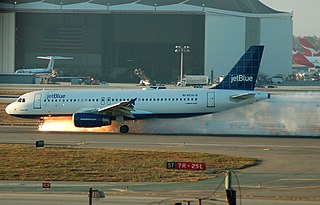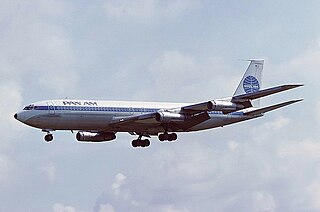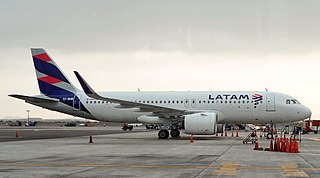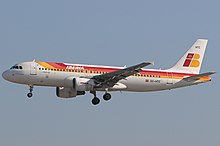
Eastern Air Lines Flight 66 was a regularly scheduled flight from New Orleans to New York City that crashed on June 24, 1975 while on approach to New York's John F. Kennedy International Airport, killing 113 of the 124 people on board. The crash was determined to be caused by wind shear caused by a microburst, but the failure of the airport and the flight crew to recognize the severe weather hazard was also a contributing factor.

USAir Flight 1016 was a regularly scheduled flight in the southeastern United States, between Columbia, South Carolina, and Charlotte, North Carolina. On July 2, 1994, the flight encountered heavy thunderstorms and microburst-induced windshear while attempting to land, and crashed into heavy trees and a private residence near the airport. The crash and ensuing fire caused 37 fatalities and seriously injured twenty others.

Air France Flight 296Q was a chartered flight of a new Airbus A320-111 operated by Air Charter International for Air France. On 26 June 1988, the plane crashed while making a low pass over Mulhouse–Habsheim Airfield as part of the Habsheim Air Show. Most of the crash sequence, which occurred in front of several thousand spectators, was caught on video.

JetBlue Flight 292 was a scheduled flight from Bob Hope Airport in Burbank, California, to John F. Kennedy International Airport in New York City. On September 21, 2005, Captain Scott Burke executed an emergency landing in the Airbus A320-232 at Los Angeles International Airport after the nose gear jammed in an abnormal position. No one was injured.

Gulf Air Flight 072 (GF072/GFA072) was a scheduled international passenger flight from Cairo International Airport in Egypt to Bahrain International Airport in Bahrain, operated by Gulf Air. On 23 August 2000 at 19:30 Arabia Standard Time (UTC+3), the Airbus A320 crashed minutes after executing a go-around upon failed attempt to land on Runway 12. The flight crew suffered from spatial disorientation during the go-around and crashed into the shallow waters of the Persian Gulf 2 km (1 nmi) from the airport. All 143 people on board the aircraft were killed.

American Airlines Flight 1572 was a flight from Chicago O'Hare International Airport to Bradley International Airport on November 12, 1995. The McDonnell Douglas MD-83 struck trees and an instrument landing system (ILS) antenna during landing, causing $9 million in damage to the aircraft.

Armavia Flight 967 was a scheduled international passenger flight operated by Armavia from Zvartnots International Airport, Zvarnots in Armenia to Sochi, a Black Sea coastal resort city in Russia. On 3 May 2006, the aircraft operating the route, an Airbus A320-200, crashed into the sea while attempting a go-around following its first approach to Sochi airport; all 113 aboard were killed. The accident was the first major commercial airline crash in 2006. It was Armavia's only fatal crash during the airline's existence.
Iberia Líneas Aéreas de España, S.A., usually shortened to Iberia, is the largest airline of Spain, based in Madrid.

Lufthansa Flight 2904 was an Airbus A320-200 flying from Frankfurt, Germany to Warsaw, Poland that overran the runway at Okęcie International Airport on 14 September 1993.

Indian Airlines Flight 605 was a scheduled domestic passenger flight from Bombay to Bangalore. On 14 February 1990, an Airbus A320-231 registered as VT-EPN, crashed onto a golf course while attempting to land at Bangalore, killing 92 of 146 people on board.

TACA Flight 390 was a scheduled flight on May 30, 2008, by TACA International from San Salvador, El Salvador, to Miami, Florida, United States, with intermediate stops at Tegucigalpa and San Pedro Sula in Honduras. The aircraft, an Airbus A320-233, overran the runway after landing at Tegucigalpa's Toncontín International Airport and rolled out into a street, crashing into an embankment and smashing several cars in the process.

Pan Am Flight 806 was an international scheduled flight from Auckland, New Zealand, to Los Angeles, California, with intermediate stops at Pago Pago, American Samoa and Honolulu, Hawaii. On January 30, 1974, the Boeing 707 Clipper Radiant crashed on approach to Pago Pago International Airport, killing 87 passengers and ten crew members.

Iberia Flight 610 was a scheduled domestic passenger flight from Madrid to Bilbao, Spain. On 19 February 1985, a Boeing 727-200 operating the flight crashed into a ravine after one of its wings sliced a television antenna on the summit of Mount Oiz in Biscay during an approach to Bilbao Airport. All 141 passengers and 7 crew on board died. The crash is the deadliest aviation disaster in both the Basque Country and Iberia history.

Air Canada Flight 624 was a scheduled Canadian domestic passenger flight from Toronto Pearson International Airport to Halifax Stanfield International Airport in Halifax, Nova Scotia. During heavy snow and poor visibility, at 00:43 ADT on 29 March 2015, the Airbus A320-211 landed short of the runway and was severely damaged. Twenty-six people were injured.

Asiana Airlines Flight 162 was a regular short-haul international passenger flight from Incheon International Airport near Seoul, South Korea, to Hiroshima Airport in Hiroshima, Japan. On 14 April 2015, the Airbus A320-232 aircraft touched down short of the runway, struck the localizer array, skidded onto the runway on its tail, and spun 120 degrees before finally coming to a rest on the grass, opposite the terminal building. The aircraft suffered substantial damage to the left wing and engine. Of the 82 people aboard, 27 were injured, one seriously.

Aeroméxico Connect Flight 2431 (SLI2431/5D2431) was a Mexican domestic scheduled passenger flight bound for Mexico City that crashed on takeoff from Durango International Airport on July 31, 2018. Shortly after becoming airborne, the plane encountered sudden wind shear caused by a microburst. The plane rapidly lost speed and altitude and impacted the runway, detaching the engines and skidding to a halt about 1,000 feet (300 m) beyond the runway. The plane caught fire and was destroyed. All 103 people on board survived, but 39 passengers and crew members were injured.

Pakistan International Airlines Flight 8303 was a scheduled domestic flight from Allama Iqbal International Airport in Lahore to Jinnah International Airport in Karachi, Pakistan. On 22 May 2020, the Airbus A320 crashed into Model Colony, a densely populated residential area of Karachi only a few kilometres from the runway, while on a second approach after a failed landing attempt with landing gear not extended. The aircraft was badly damaged in the first belly landing, with both engines flaming out during the go-around. Of the 91 passengers and 8 crew on board the aircraft, 97 were killed, and two passengers survived with injuries. Eight people on the ground were also injured in the accident, one of whom later succumbed to her injuries.

LATAM Airlines Perú Flight 2213 was a scheduled domestic passenger flight in Peru from Lima to Juliaca. On 18 November 2022, the Airbus A320neo was taking off from Jorge Chávez International Airport when it collided with a fire engine that was crossing the runway, killing two firefighters and injuring a third, who died of his injuries seven months later. 40 passengers were injured. The aircraft was damaged beyond repair and written off, making it the first hull loss of the Airbus A320neo family.

















